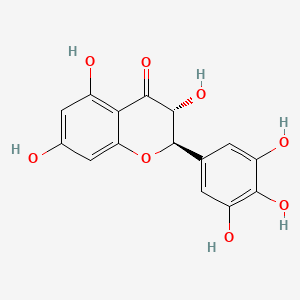Ferroptosis-centered Drug Response Information
General Information of the Drug (ID: ferrodrug0185)
| Name |
Dihydromyricetin
|
||||
|---|---|---|---|---|---|
| Synonyms |
Dihydromyricetin; Ampelopsin; 27200-12-0; Ampeloptin; (+)-Dihydromyricetin; (+)-Ampelopsin; (2r,3r)-3,5,7-trihydroxy-2-(3,4,5-trihydroxyphenyl)chroman-4-one; Telocapil; Myriceline spe; C15H12O8; Flavanone, 3,3',4',5,5',7-hexahydroxy-; 4H-1-Benzopyran-4-one, 2,3-dihydro-3,5,7-trihydroxy-2-(3,4,5-trihydroxyphenyl)-, (2R-trans)-; (2R,3R)-3,5,7-trihydroxy-2-(3,4,5-trihydroxyphenyl)-2,3-dihydrochromen-4-one; KD8QND6427; CHEBI:28429; 4H-1-Benzopyran-4-one, 2,3-dihydro-3,5,7-trihydroxy-2-(3,4,5-trihydroxyphenyl)-, (2R,3R)-; (2R,3R)-2,3-dihydro-3,5,7-trihydroxy-2-(3,4,5-trihydroxyphenyl)-4H-1-benzopyran-4-one; (2R,3R)-3,5,7,3',4',5'-hexahydroxyflavanone; Ampelopsin (flavanol); (2R,3R)-3,3',4',5,5',7-hexahydroxy-2,3-dihydroflavanonol; dihydro-myricetin; Ampelopsin;Ampeloptin; (2R,3R)-3,5,7-trihydroxy-2-(3,4,5-trihydroxyphenyl)-2,3-dihydro-4H-chromen-4-one; UNII-KD8QND6427; 3,3',4',5,5',7-Hexahydroxy-2,3-dihydroflavanonol; AMPELOPSIN [MI]; (2r,3r)-dihydromyricetin; Dihydromyricetin (diH-Myr); (2R-trans)-2,3-Dihydro-3,5,7-trihydroxy-2-(3,4,5-trihydroxyphenyl)-4H-1-benzopyran-4-one; Dihydromyricetin (Ampeloptin); Dihydromyricetin - Ampeloptin; SCHEMBL723736; DIHYDROMYRICETIN [INCI]; CHEMBL3348861; DTXSID50181676; BDBM212434; HMS3884B17; Dihydromyricetin, >=98% (HPLC); HY-N0112; Dihydromyricetin, analytical standard; MFCD00189451; s2399; AKOS022168215; AC-8004; CCG-267699; CS-3809; NCGC00346604-01; AS-71702; D5464; SW219328-1; C02906; A818952; Q422305; 2B89FBAC-4DD1-44C9-BE2A-9D0C173BDFD8; Q-100341; (2R,3R)-3,5,7-trihydroxy-2-(3,4,5-trihydroxyphenyl)-3,4-dihydro-2H-1-benzopyran-4-one
Click to Show/Hide
|
||||
| Structure |
 |
||||
| Formula |
C15H12O8
|
||||
| IUPAC Name |
(2R,3R)-3,5,7-trihydroxy-2-(3,4,5-trihydroxyphenyl)-2,3-dihydrochromen-4-one
|
||||
| Canonical SMILES |
C1=C(C=C(C(=C1O)O)O)C2C(C(=O)C3=C(C=C(C=C3O2)O)O)O
|
||||
| InChI |
InChI=1S/C15H12O8/c16-6-3-7(17)11-10(4-6)23-15(14(22)13(11)21)5-1-8(18)12(20)9(19)2-5/h1-4,14-20,22H/t14-,15+/m0/s1
|
||||
| InChIKey |
KJXSIXMJHKAJOD-LSDHHAIUSA-N
|
||||
| PubChem CID | |||||
Full List of Ferroptosis Target Related to This Drug
Phospholipid hydroperoxide glutathione peroxidase (GPX4)
| In total 2 item(s) under this Target | |||||
| Experiment 1 Reporting the Ferroptosis-centered Drug Act on This Target | [1] | ||||
| Target for Ferroptosis | Suppressor | ||||
| Responsed Disease | Cerebral ischemia | ICD-11: 8B10 | |||
| Responsed Regulator | Sphingosine kinase 1 (SPHK1) | Driver | |||
| Pathway Response | Ferroptosis | hsa04216 | |||
| Cell Process | Cell ferroptosis | ||||
| In Vitro Model | HT22 cells | Normal | Mus musculus | CVCL_0321 | |
| In Vivo Model |
Rats were anesthetized by pentobarbital sodium at a dosage of 40 mg/kg by intraperitoneal injection. Rats were first anchored on to an operating table in the supine position. The fur around the incision was shaved and then disinfected. Subsequently, the neck of each rat was incised in the middle to expose the right common carotid artery (CCA), external carotid artery (ECA) and internal carotid artery (ICA). The proximal end of the CCA and ECA were ligated and severed using a 0.285 mm nylon suture. The suture was inserted from the ECA stump through the ICA to reach the MCA. The MCA was then occluded for 2 h to create ischemic conditions. Next, the nylon suture was slowly pulled out to restore blood flow and simulate reperfusion condition.
Click to Show/Hide
|
||||
| Response regulation | Dihydromyricetin (DHM) repressed ferroptosis by inhibiting the SPHK1/mTOR signaling pathway, thereby alleviating cerebral ischemia reperfusion injury. Moreover, the expression levels of glutathione peroxidase 4 (GPX4) was enhanced while the levels of acyl-CoA synthetase long-chain family member 4 (ACSL4) and phosphatidylethanolamine binding protein 1 (PEBP1) were reduced in OGD/R-treated HT22 cells in the presence of DHM. | ||||
| Experiment 2 Reporting the Ferroptosis-centered Drug Act on This Target | [1] | ||||
| Target for Ferroptosis | Suppressor | ||||
| Responsed Disease | Cerebral ischemia | ICD-11: 8B10 | |||
| Responsed Regulator | Serine/threonine-protein kinase mTOR (MTOR) | Driver | |||
| Pathway Response | Ferroptosis | hsa04216 | |||
| Cell Process | Cell ferroptosis | ||||
| In Vitro Model | HT22 cells | Normal | Mus musculus | CVCL_0321 | |
| In Vivo Model |
Rats were anesthetized by pentobarbital sodium at a dosage of 40 mg/kg by intraperitoneal injection. Rats were first anchored on to an operating table in the supine position. The fur around the incision was shaved and then disinfected. Subsequently, the neck of each rat was incised in the middle to expose the right common carotid artery (CCA), external carotid artery (ECA) and internal carotid artery (ICA). The proximal end of the CCA and ECA were ligated and severed using a 0.285 mm nylon suture. The suture was inserted from the ECA stump through the ICA to reach the MCA. The MCA was then occluded for 2 h to create ischemic conditions. Next, the nylon suture was slowly pulled out to restore blood flow and simulate reperfusion condition.
Click to Show/Hide
|
||||
| Response regulation | Dihydromyricetin (DHM) repressed ferroptosis by inhibiting the SPHK1/ mTOR signaling pathway, thereby alleviating cerebral ischemia reperfusion injury. Moreover, the expression levels of glutathione peroxidase 4 (GPX4) was enhanced while the levels of acyl-CoA synthetase long-chain family member 4 (ACSL4) and phosphatidylethanolamine binding protein 1 (PEBP1) were reduced in OGD/R-treated HT22 cells in the presence of DHM. | ||||
4F2 cell-surface antigen heavy chain (SLC3A2)
| In total 1 item(s) under this Target | |||||
| Experiment 1 Reporting the Ferroptosis-centered Drug Act on This Target | [2] | ||||
| Target for Ferroptosis | Suppressor | ||||
| Responsed Disease | Intracerebral hemorrhage | ICD-11: 8B00 | |||
| Responsed Regulator | Neutrophil gelatinase-associated lipocalin (LCN2) | Driver | |||
| Pathway Response | Fatty acid metabolism | hsa01212 | |||
| Ferroptosis | hsa04216 | ||||
| Cell Process | Cell ferroptosis | ||||
| In Vitro Model | hBCs (Brain cells) | ||||
| In Vivo Model |
Male C57BL/6 mice, aged 8-10 weeks and weighing 22-25 g, were purchased from the Hubei Provincial Center for Disease Control and Prevention in Wuhan, China. Mice were initially administered with 1% sodium pentobarbital (70 mg/kg; Sinopharm Chemical Agent Co., Ltd., Shanghai, China) intraperitoneally. Subsequently, they were secured on a stereotaxic device (RWD Life Science Co., Shenzhen). 0.6 ul of collagenase (1 ku/ml) was injected into the caudate nucleus of the mice (bregma 0: 0.5 mm anterior, 2 mm left lateral and 3.5 mm deep) with the help of a brain stereotactic sampling needle (Hamilton).
Click to Show/Hide
|
||||
| Response regulation | Dihydromyricetin (DMY) may attenuate symptoms of intracerebral hemorrhage (ICH) in mice, and its potential mechanisms are closely linked to LCN2/system Xc-. The ICH-induced augmentation of LCN2 expression leads to the formation of LCN2-SLC3A2 complexes, which suppress the transport activity of system Xc- and result in the accumulation of ROS and the emergence of ferroptosis. | ||||
References
